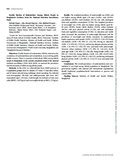Double burden of malnutrition among elderly people in Bangladesh: Evidence from the National Nutrition Surveillance Study

View/Open
Date
2020-06Publisher
Oxford AcademicAuthor
Hasan, MehediShamim, Abu Ahmed
Hossain, Md. Mokbul
Hanif, Abu Abdullah Mohammad
Hossaine, Moyazzam
Ullah, Mohammad Aman
Sarker, Samir Kanti
Rahman, S M Mustafizur
Mitra, Dipak Kumar
Haque, Md. Emdadul
Mridha, Malay
Metadata
Show full item recordCitation
Double burden of malnutrition among elderly people in Bangladesh: Evidence from the National Nutrition Surveillance StudyAbstract
Objectives:
Double burden of malnutrition (DBM), referred as the coexistence of undernutrition and overnutrition, is an evolving public health concern. There is a paucity of data about DBM among elderly people in Bangladesh. In the recently completed round of the national nutrition surveillance (NNS 2018–2019), we assessed the prevalence and determinants of DBM among elderly people.
Methods
In the NNS, we collected data from 30,005 persons in 6 population groups from 82 clusters (57 rural, 15 non-slum urban, and 10 slums) selected using multistage cluster sampling. We collected socio-demographic, life-style and anthropometric data from 4817 respondents aged >60 years. Underweight was defined as body mass index (BMI) <18.5 kg/m2 and overweight/obesity as BMI ≥ 23 kg/m2.
Results
The weighted prevalence of underweight was 26.8%, and was higher among elderly aged ≥70 years (34.4%), male (28.5%), non-diabetic (28.5%), rural residents (27.1%) and with inadequate fruits and vegetables consumption (27.1%). The weighted prevalence of overweight was 27.0%, and was higher among elderly aged 60–69 years (29.8%), female (30.8), diabetic (51.0%), urban residents (48.2%), with poor physical activity (31.3%), and with inadequate fruits and vegetables consumption (27.4%). As education and wealth status increased, the prevalence of underweight decreased and the prevalence of overweight and obesity increased. In multivariable logistic regression, male gender (AOR: 1.33, 95% CI: 1.18,1.51), being non-diabetic (AOR: 1.50, 95% CI: 1.23,1.82), having no education (AOR: 1.73, 95% CI: 1.35,2.22), and having adequate physical activity (AOR: 1.19, 95% CI: 1.05,1.35) were associated with underweight. However, urban residency (AOR: 1.73, 95% CI: 1.41,2.12), 60–69 years age (AOR: 1.59, 95% CI: 1.36,1.85), being female (AOR: 1.81, 95% CI: 1.56,2.10), having diabetes (AOR: 2.52, 95% CI:2.07,3.08), being Muslim (AOR: 1.25, 95% CI: 1.04,1.53), and having inadequate physical activity (AOR: 1.36, 95% CI: 1.18,1.57) were associated with overweight.
Conclusions
The overall prevalence of undernutrition and overnutrition is very high among elderly population in Bangladesh. The government together with national and international organizations should implement population-based interventions to prevent and control DBM.
